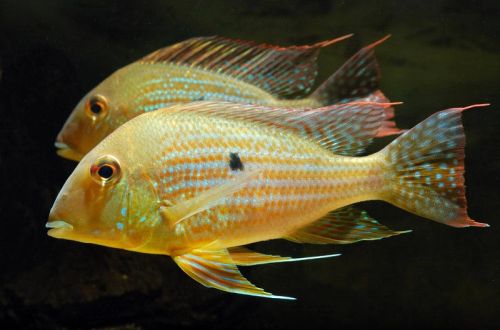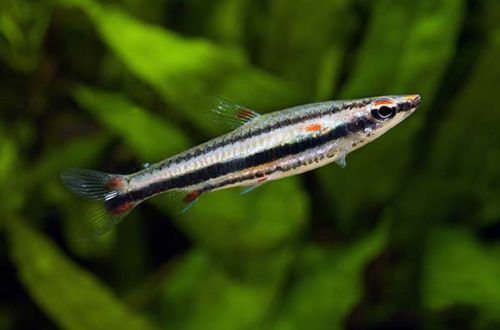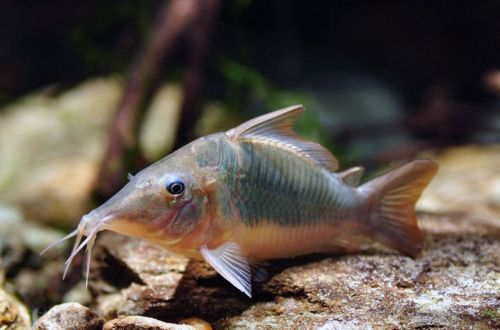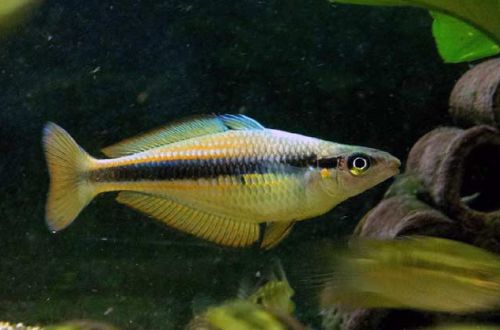
Geophagus Neambi
Geophagus Neambi or Geophagus Tocantins, scientific name Geophagus neambi, belongs to the Cichlidae family. The name of the fish comes from the abbreviation NEAMB, which stands for and translates from Portuguese as the Federal University of the State of Tocantins (Brazil). This is a sign of recognition of the efforts of scientists of this university in the study of the ichthyofauna of the river of the same name.
A popular representative of this genus of American cichlids. Widely available commercially. Easy to keep and breed, perfectly compatible with other types of fish.

Contents
Habitat
It comes from South America from the basin of the Tocantins River, one of the largest on the continent. The natural habitat is similar to that of the Geophagus in the Amazon. Fish prefer shallow sections of rivers with a gently sloping sandy bottom near the coast or islands. Depending on the area, typical elements of the biotope can be roots and fallen branches of trees, stones, and various plant debris.
Brief information:
- The volume of the aquarium – from 600 liters.
- Temperature – 24-32°C
- Value pH — 5.5–7.5
- Water hardness – 1–10 dGH
- Substrate type – sandy
- Lighting – subdued
- Brackish water – no
- Water movement is weak
- The size of the fish is 17–20 cm.
- Food – any sinking food
- Temperament – peaceful
- Content in a group of at least 5–8 individuals
Description

Adult individuals reach a length of 17–20 cm. Sexual dimorphism is weakly expressed. There are no clear visible differences between male and female. The coloration is yellow-orange with rows of horizontal blue stripes. Fins and tail are red with turquoise markings. There is a dark large spot in the middle of the body.
Food
They feed near the bottom, sifting portions of soil with their mouths in search of small invertebrates. Most popular aquarium fish foods will be accepted in the home aquarium. An important condition is that they must be sinking and consist of small particles. Despite their size, fish cannot eat large pieces of food that are likely to get stuck in the mouth.
Maintenance and care, arrangement of the aquarium
The optimal size of the aquarium for a group of 5-8 fish starts from 600 liters. The design is arbitrary, at the discretion of the aquarist. However, if possible, it is desirable to bring the design closer to conditions resembling a natural habitat – a subdued level of illumination, a lot of snags, large fragments of rocks, boulders. The only thing you need to pay attention to is the substrate. Due to the feeding habits of this species of cichlids, only sandy soil should be used.
Geophagus Neambi is extremely sensitive to the deterioration of water quality and fluctuations in hydrochemical values and temperatures, so it should not be introduced into a biologically immature aquarium. Achieving the desired stability of water conditions is ensured by a productive filtration system and regular aquarium maintenance procedures. The latter include weekly replacement of part of the water with fresh water, timely removal of organic waste, water control for the content of dangerous concentrations of nitrogen cycle products (ammonia, nitrites, nitrates).
Behavior and Compatibility
Peaceful calm fish, except during spawning periods, when Geophagus become intolerant of other fish in an effort to protect their offspring. There will be no problems if they are in a spacious aquarium. Otherwise, it may be necessary to transplant a male/female pair. Otherwise perfectly compatible with other non-aggressive freshwater species.
Intraspecific relationships are built on an internal hierarchy, where Affa males occupy a dominant position. The size of the group must be maintained in the amount of at least 5–8 fish, otherwise weak individuals will be attacked by stronger and larger counterparts.
Breeding / breeding
Breeding Geophagus Tocantins is quite simple. Under favorable conditions (high water quality and a balanced diet), spawning occurs regularly. Fish reach sexual maturity by one year. With the onset of the mating season, the male and female form a temporary pair. Having occupied a site at the bottom of the aquarium, they choose a suitable place for spawning, usually a stone or a piece of driftwood, and lay up to 200 eggs.
The female stays close to the clutch to protect her, while the male “patrols” the surroundings and drives away any fish that he considers potentially dangerous. In some cases, the female may take the eggs into her mouth for greater safety. The fry appear after a few days. For a couple of weeks, parents guard the brood, after which they let them swim freely.
Fish diseases
The main cause of diseases lies in the conditions of detention, if they go beyond the permissible range, then immunity suppression inevitably occurs and the fish becomes susceptible to various infections that are inevitably present in the environment. If the first suspicions arise that the fish is sick, the first step is to check the water parameters and the presence of dangerous concentrations of nitrogen cycle products. Restoration of normal/suitable conditions often promotes healing. However, in some cases, medical treatment is indispensable. Read more about symptoms and treatments in the Aquarium Fish Diseases section.





